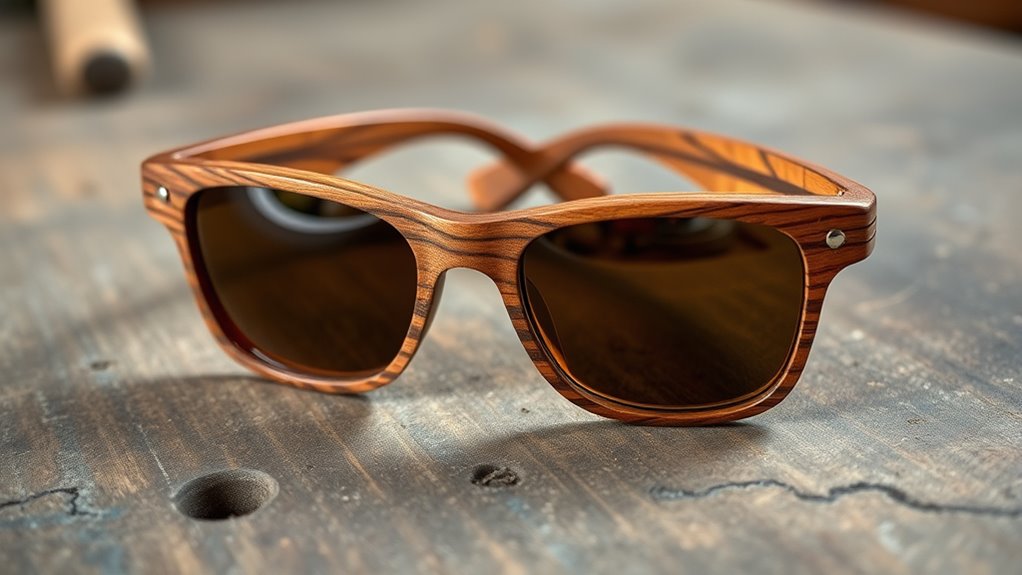To make stylish DIY wooden sunglasses, start by choosing sustainable woods like bamboo or reclaimed hardwoods, then prepare thin veneers for lamination. Spread an appropriate adhesive evenly and layer the veneers to achieve your desired thickness, pressing firmly for several hours. Shape the laminated layers with hand tools, paying attention to curves and angles, and then sand to smooth all edges. Incorporate unique design details to boost style and durability—stick around for more tips on mastering this eco-friendly craft.
Key Takeaways
- Select sustainable, thin wood veneers like bamboo or reclaimed hardwoods suitable for lamination.
- Apply an even adhesive layer to veneers to ensure a smooth, bubble-free lamination process.
- Layer and press veneers with clamps or weights for several hours until fully cured.
- Carefully shape the laminated wood into sunglasses frames using hand tools and precision carving.
- Finish with sanding and polishing to highlight natural textures, creating stylish, eco-friendly sunglasses.

Have you ever wanted a stylish accessory that’s also eco-friendly? Creating your own wooden sunglasses allows you to do just that. By choosing sustainable materials, you guarantee your project minimizes environmental impact while showcasing your craftsmanship skills. Laminating thin veneers is a key step in crafting sunglasses that are both durable and visually striking. It’s a process that requires patience and attention to detail, but the results are well worth it. When selecting materials, opt for sustainably sourced woods like bamboo, cork, or reclaimed hardwoods. These choices not only reduce your carbon footprint but also add unique character to each pair of sunglasses. The craftsmanship techniques involved emphasize precision and care; you’ll learn how to handle veneers delicately, guaranteeing they don’t crack or warp during lamination.
To begin, gather thin wood veneers, adhesive suitable for wood, and clamps or weights to press the layers together. Applying the right amount of adhesive evenly is essential for a tight bond. Spread the glue carefully across the veneer surfaces, then layer them to achieve the desired thickness and shape for your sunglasses. The lamination process involves pressing the layers together for several hours, allowing the adhesive to cure fully. This step is indispensable in creating a sturdy, lightweight frame that’s comfortable to wear. As you work through the lamination, you develop your craftsmanship techniques—learning how to handle delicate materials, maintain even pressure, and avoid air bubbles or gaps. Additionally, understanding wood properties can help you select the best veneers for durability and aesthetics.
Once the laminated block has set, you can begin shaping it into the familiar form of sunglasses. Using a combination of hand tools and precision cutting, you carve out the frame, paying attention to the curves and angles that will fit your face comfortably. Sanding is an essential part of the process, smoothing out rough edges and highlighting the natural beauty of the wood grain. You may also incorporate design elements like beveled edges or intricate inlays to personalize your sunglasses further. Throughout this process, your focus on sustainable materials and craftsmanship techniques results in a pair of sunglasses that are both eco-conscious and stylish. The natural warmth and texture of the wood make each piece unique, giving you a sense of pride in creating something functional and beautiful with your own hands.
Frequently Asked Questions
What Types of Wood Are Best for DIY Sunglasses?
When choosing wood for your DIY sunglasses, you want to contemplate wood grain and veneer thickness. Hardwoods like maple, walnut, and cherry are ideal because they’re durable and have attractive grain patterns. Keep the veneer thin enough—around 0.6-1mm—so it’s easy to laminate and shape without cracking. These woods and proper veneer thickness give your sunglasses a stylish, lightweight feel while ensuring they last.
How Long Does the Lamination Process Typically Take?
The lamination duration varies depending on the materials and methods you use, but it usually takes about 1 to 3 hours. You’ll want to factor in the drying time, which can range from 30 minutes to several hours, especially if you’re using glue or adhesive. Make sure to apply even pressure during lamination and give it enough drying time for a secure, smooth finish on your wooden sunglasses.
Can I Customize the Lens Shape and Size?
Imagine your sunglasses as a canvas for creativity; yes, you can totally customize the lens shape and size. With some patience and the right tools, lens customization becomes an enjoyable part of your DIY project. You’ll want to carefully select or craft lenses that fit your desired shape and size, ensuring they blend seamlessly with your wooden frames. This way, your sunglasses reflect your unique style and personality.
What Safety Precautions Are Necessary During Construction?
When constructing your wooden sunglasses, you should prioritize safety. Always wear eye protection to shield your eyes from debris and dust. Work in a well-ventilated area to prevent inhaling fumes from adhesives or finishes. Use appropriate tools carefully, and follow instructions closely to avoid accidents. Taking these precautions guarantees your project is safe, enjoyable, and results in a stylish pair of sunglasses you can be proud of.
How Do I Ensure the Sunglasses Are UV Protective?
So, you want your DIY sunglasses to block those pesky UV rays? Easy! Just apply high-quality UV protection coatings to your lenses—think of it as sunscreen for your eyes. For extra flair, choose polarized lens options, which cut glare and boost clarity. Remember, the secret’s in the coating. If you skip it, your stylish shades might just be fashionable eye protectors, not actual shields. Stay safe, stay stylish!
Conclusion
Crafting your own wooden sunglasses blends craftsmanship with personal style, turning raw veneers into a functional work of art. Just like the delicate layers you laminate, your effort creates a sturdy, stylish accessory that contrasts nature’s fragility with durability. In this process, you become both artist and engineer, shaping something unique from simple materials. So, embrace the blend of tradition and innovation—because in the end, your handmade sunglasses are a proof of your creativity and resilience.









